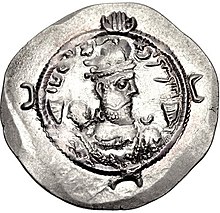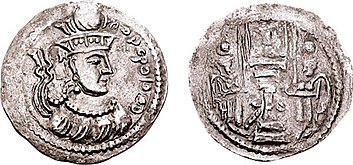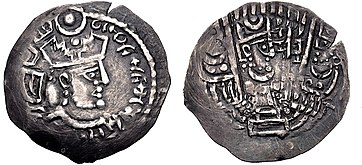|
利用者:Lin Xiangru/sandboxサーサーン朝の通貨 アルダシール1世(在位:224年〜242年)のディナール金貨。クテシフォンで鋳造された。 サーサーン朝の通貨はサーサーン朝(224年〜651年)が鋳造した貨幣(主に硬貨)である。古代末期において、サーサーン朝はローマ帝国と並んで、重要な貨幣発行国であった[1]。そのためサーサーン朝の硬貨は他国にも影響を及ぼした[2][1]。サーサーン時代の研究にとって、硬貨は極めて重要な一次資料であり、美術史においても極めて重要なものである[2][3]。Sylloge nummorum Sasanidarumはサーサーン朝の通貨についての最も重要な一次資料である[2]。 概説   サーサーン朝で主に流通していた硬貨はドラクマ硬貨(中期ペルシア語:drahm)である。前王朝アルサケス朝でも導入され、サーサーン朝初代シャーハンシャー(以下王とする)アルダシール1世(在位:224年〜242年)の鋳造以降サーサーン朝でも代々鋳造された[2][4]。直径259 〜30mm、重さ約4グラムと大型で薄く、当時としては目新しい貨幣である。高純度の銀製で、サーサーン朝のすべての王が大量に生産した。また補助通貨にあたる、単位以下の銀貨も発行されている[2][3]。ヘミドラクマ(0.5ドラクマ)、オボルス(1/6ドラクマ)、さらにはテトラドラクマ(4ドラクマ)などがある[3]。アルダシール1世は、出身地ペルシス(パルス)の既存の通貨制度から、ヘミドラクマとオボルズをそのまま受け継いだと思われる[3]。銅貨やまれにではあるが鉛貨も発行された。 しかし、テトラドラクマは、ほとんど銅製で銀の含有量が僅かであったために、サーサーン朝初期のバハラーム1世(在位:271年〜274年)の治世には不評となっていた[4]。ヘミドラクマも同様にサーサーン朝初期のみ流通していた[4]。オボルズやヘミオボルズは比較的長い間使用されてはいるが、実際は即位式での下賜品、民衆への施しといった特別な儀式の際に散発的に使用されるもので、日常的に使うものではなかった[4]。そのような不人気を受け、ヘミドラクマとテトラドラクマはバハラーム2世(在位:274年〜293年) 274-93)の治世下で廃止された。オボルズの派生硬貨であるダング(dang、中期ペルシア語)は、6世紀初頭のカワード1世の治世の終わりまで鋳造された[4][5]。 金貨は限られた量しか発行されず、その鋳造目的も「宣伝や、ローマ帝国、クシャーナ朝の金貨との競合」であった[2]。ディナール(中期ペルシア語:dēnār、ラテン語のdenarius aureusに由来)金貨は、初代アルダシール1世が発行した[6][3]。アルサケス朝では、金貨の発行されている形跡があまり見つかっていない[3]。シャープール3世の治世(在位:383年〜388年)まで、サーサーン朝の金貨の重さは7〜7.4グラムだった[6]。また金貨以上に、銅貨の鋳造は非常に少なかった [5]。 400年にわたるサーサーン朝の統治下で、硬貨の鋳造権はサーサーン王家のみの特権であり、帝国全土で同一の意匠の硬貨が使用されたことは、サーサーン朝がサーサーン家の権威が帝国全土に及んでいたを示す[2][3]。税金の支払いの他に、どのような状況で硬貨が貨幣として使われたかは不明である[2]。しかし、大半の硬貨は兵士に対する給料として使っていたことは知られている[4]。Philippe Gignoux(フランス語版)とマイケル・ベイツによれば、シャープール2世(在位:309年〜379年)とペーローズ1世(在位:459年〜484年)の治世下では、多数の軍事作戦を行っているため、必然的に硬貨の発行量も増えているはずだと主張している[4]。実際に、カワード1世・ホスロー1世(在位:531年〜579年)・ホスロー2世(在位:590年〜628年)といった多数の戦闘を行っていた時期の硬貨は多数見られる[4]。その硬貨はローマ帝国と同様に「正確でよく組織された工程」に従って全てを手作業で鋳造された[3]。 図像と様式サーサーン朝の硬貨は3世紀から7世紀にわたって同様の図像学をとどめていた。しかし、様式の観点からは「肖像や裏面の文様は次第に記号化するようになった」と指摘されている。Rebecca DarleyとMatthew Canepaによると[2]、
シンド製の硬貨→詳細は「シンド製のサーサーン朝の通貨」を参照
 シンド製のサーサーン朝の通貨とは、現在のパキスタン南部のシンドで325年から480年、すなわちシャープール2世からペーローズ1世までの統治期間に鋳造された一連の貨幣である[7]。これらの貨幣はそれ以前にも引き継がれていたいくつかの貨幣の特徴を持っている。クシャーノ・サーサーン朝の硬貨とまとめて、インド・ササニアン(Indo-Sasanian)とも呼ばれる[8]。これらの貨幣もサーサーン朝の経済に重要な役割を果たした。 Sasanian coinage of Iberia (Georgia)Although various hoards have been found in what is present-day Georgia containing regular Sasanian coinage, no local mint mark has been identified thus far for these regular Sasanian coins. However, so-called Kartvelo-Sasanian coins were produced locally in Kartli during the later period of Sasanid suzerainty and rule over central-eastern Georgia (Iberia of the classical authors), that is, in the late 6th and first half of the 7th century. As all extant coins of this type are decorated on the obverse with an image of either Hormizd IV or Khosrow II, there are no Kartvelo-Sasanian coins that predate Hormizd IV's rule (which started in 579). The production of Kartvelo-Sasanian coins commenced after the suppression of the Iberian monarchy by the Sasanids, dated by Cyril Toumanoff to c. 580.[9] Kartvelo-Sasanian coins are usually decorated with asomtavruli letters and/or monograms. These monograms usually represented the names of the prominent and contemporaneous eristavis and presiding princes (eristavta-mtavaris) of Iberia. The earliest Kartvelo-Sasanian coins, as part of the first phase, were inscribed JO, which according to Stephen H. Rapp Jr translates as “O, Cross”. Once the Principality of Iberia was firmly established, the inscriptions, in this second phase, shifted to monograms which mentioned the name of the presiding princes. Examples amongst such are GN and GRG, i.e. "Gurgen/Guaram" respectively; both abbreviations are identified with prince Guaram I ((在位: [[{{{1}}}年]] - [[{{{2}}}年]]) 588-590). Presiding princes who followed after this phase were even bolder in the presentation of their religious affiliation. In this third and final phase of Kartvelo-Sasanian coins a small cross can be distinguished as a replacement for the sacred Zoroastrian flame atop the fire altar. This series commences with the abbreviation SPNS, i.e. "Stepanoz I", positioned around the image of the Sasanian Shahanshah Hormizd VI. The text does not obstruct the reading of the typically used Middle Persian legend. These adaptations develop further during Stepanoz I's reign (590–627), or perhaps during the reign of Stepanoz II (642–650). In this sub-phase, the full inscription of the name "Stepanoz" can be viewed on both sides of the head of the Sasanian Shahanshah, and the Middle Persian inscription depicting the name and regnal year of the Shahanshah is eliminated.[10]
各地への影響DarleyやCanepaによると、ササン朝の硬貨は、特に中央アジアや中国との貿易で広く流通したため、エフタルやキダーラ朝などのサーサーン朝に隣接する勢力で鋳造された貨幣のモデルとなった[2]。ムスリムによってサーサーン朝が征服された後も、ウマイヤ朝は貨幣にサーサーン朝の貨幣の特徴が見られるが、アラビア語の銘を加えている独自面も見られる[2]。ただし、この時期の貨幣の中にはアラビア語の文字が刻まれていないものもあった[11] 。これらの貨幣の特徴をアラブ・ササニアン様式と呼ぶ。サーサーン朝の中心地で鋳造され、サーサーン朝の貨幣で常に描かれたゾロアスター教の象徴火の祭壇が描かれている[2][11]。ウマイヤ朝カリフアブドゥルマリク(在位:685年〜705年)は「像を用いない」新たなイスラームのディルハム銀貨を鋳造したが、銀の構成割合や分厚い側面などといったサーサーン朝の特徴を引き継いでいる[2]。
インド・ササニアン様式の硬貨→詳細は「インド・ササニアン様式の貨幣」を参照
インドには「インド・ササニアン様式」と呼ばれる形式の硬貨がある。サーサーン朝の硬貨のデザインのうち、幾何学的文様を派生させたものであり、西暦530年頃から西暦1202年頃まで流通した。グルジャル族のプラティハーラ朝、チャウルキヤ朝、パラマーラ朝、パーラ朝の間で使用されていた。インド・ササニアン様式の硬貨は、表面の王の絵については、単純化され幾何学的文様になっており、裏面には、従者がいるときもいないときもあるが火の祭壇のデザインが幾何学的な文様として描かれている[19][20]
各皇帝の貨幣
ナルセ1世ナルセ1世(293年-302年)の硬貨に刻まれた称号は、「 Mazdēsn bay Narsē šāhān šāh Ērān ud Anērān kēčihr az yazdān ("マズダーを崇拝する神聖なるナルセ、イラン(人)と非イラン(人)の諸王の王かつ、神々に由来する姿と輝きを持つ者)」であった[23][24]。またナルセの硬貨の意匠は、主に3つに分類できる。1つ目と2つ目の硬貨では、ナルセがパルメット柄の王冠をかぶっているのに対して、3つ目の硬貨では、薄板状の王冠をかぶっていて、それぞれ髪型が異なる[25]。
アードゥルナルセ
ホルミズド3世ホルミズド3世(457年-459年)の硬貨は未発見[27]。
バハラーム6世  バハラーム6世(バハラーム・チョービン、590年〜591年)はホルミズド4世の対立王として即位した。同時に硬貨の鋳造を始めたが、バハラームの即位1年目には、ほとんどの地域がホルミズド4世の硬貨を継続して鋳造していた。サーサーン朝の各地では反逆者バハラームの統治を認められなかったことを示している。在位2年目でも硬貨の鋳造は、彼の勢力基盤レイイやホラーサーンのみに限られている。
関連項目脚注
同時期に、マーフ・アードゥル・グシュナスプの兄弟ナルシにカシュカルが与えられた[1]。優秀な大宰相の下でも、サーサーン朝が置かれた状況は依然として厳しいものであった。アルダシールの祖父ホスロー2世の治世中に出現した、様々な派閥がサーサーン朝の要所を支配し、派閥主義がはびこる一方で、中央集権性はより弱まっていった。アルダシール3世が即位した際には、「パフラブ」(パルティア)派と「ペルシグ」(ペルシャ)派の主要両派、そして「Nimruzi」と呼ばれる第三派閥の全ての指示を受けていた[2]。しかし、629年になると、Nimruziはアルダシール支持を取り消して、将軍シャフルバラーズと共謀してアルダシール打倒を計画し始めた[3]。対してパフラブ派は、イスパフベダーン家のファッルフ・ホルミズド・ホルミズドの指揮のもと、アルダシールの叔母ボーラーンを擁立することを決め、ボーラーンはアーモル、ニーシャープール、ゴルガーン、レイなどのパフラブ地域で硬貨の鋳造を始めた[3]。 シャフルバラーズは6,000人の軍勢を率いてクテシフォンに進軍し、包囲戦を展開した[4]。しかし、シャフルバラーズはクテシフォンを攻略することができず、。Shahrbaraz, however, was unable to capture the city, and then made an alliance with Piruz Khosrow, the leader of the Parsig, and the previous minister of the Empire during the reign of Ardashir's father.[5] With the support of both the Parsig and Nimruzi, Shahrbaraz captured Ctesiphon and executed Ardashir, Mah-Adhur Gushnasp himself, and many other prominent nobles.[4] Shahrbaraz then ascended the Iranian throne. According to late folklore, Ardashir was buried at an unknown place in Meshan.[4] 参考文献
関連文献
外部リンクし
シーリーン(شیرین、生年不明〜628年)はサーサーン朝の皇帝(シャーハンシャー)ホスロー2世の妃。ホスロー2世とシーリーンの悲劇的な恋愛物語が、後にニザーミーによって叙情詩「ホスローとシーリーン」に描かれたことで有名である。 ホスローの父ホルミズド4世の死後のクーデターで、将軍バハラーム・チョービンがサーサーン朝の実権を握ると、シーリーンはホスローとともに東ローマ帝国領シリアに逃亡して、皇帝マウリキウスの保護下で暮らした。 591年、ホスローはサーサーン朝の支配権を奪還した。愛妾であるシーリーンはその影響力を利用して、サーサーン朝において少数派のキリスト教徒を支援した。当初シーリーンは東方教会に所属していたが、後にアンティオキアの合性論派[注釈 1]教会(現在のシリア正教会)に加わった。602年から628年に起きた東ローマ・サーサーン戦争の最中、ホスローが614年にエルサレムを征服すると、イエスの聖十字架(磔に使われた十字架)を略奪し、首都クテシフォンに持ち帰った。シーリーンはその聖十字架を自身の宮殿に持ち去った。シーリーンは後継者争いにも介入し、ホスロー2世はシーリーンとの間の子マルダーンシャーを後継者に定めた。しかし、628年にホスローが正妻との間の子シェーローエがクーデターを起こしホスローを廃位すると、ホスローやマルダンシャーは処刑された。その後を追うようにシーリーンも同年に自殺した。 シーリーンは誠実な恋人であり妻のモデルとして、ペルシア文学において重要なヒロインとなった。フィルドゥシーの『シャー・ナーメ』やニザーミーの叙情詩『ホスローとシーリーン』を始めとして、多くの作品に登場している。文学作品としてのシーリーンの物語は、残っていた僅かなその人生に関する歴史的事実と類似していない事が多いが、シーリーンの合性論(単性論)キリスト教信仰や夫ホスローの暗殺後の苦難、そしてホスローが王位を取り戻すまでの亡命生活といった事実も物語の一部となっている。『ホスローとシーリーン』では、2人の偶然の出会いから始まり、しばしば離れ離れになりながらも、多くの紆余曲折を経て求愛しあった。ホスローの息子がホスローを殺すと、その息子もシーリーンに結婚を要求したが、自殺することでそれを逃れた[7]。 出自シーリーンの出自はよくわかっていない。7世紀のアルメニア人歴史家セベオス(661年没)は、サーサーン朝南西部のフーゼスターン州出身としている [8]。しかし、シリアの年代記2冊には、シーリーンを「アラム人」、つまりBeth Aramaye地方出身の人物と記述している[9]。イラン百科事典ではシーリーンをアルメニア人としているなどそのような伝承もあるが、これは後世になって作られた作り話とされる[9]。 ペルシア人歴史家のミールホーンド(1148年没)が、シーリーンはホスロー2世が10代の頃によく訪れていたペルシャ人の家で召使いをしていたと記述がある[10]。サーサーン朝時代に編纂されたフワダーイ・ナーマグを元に、11世紀に成立した、フィルドゥシーの傑作シャー・ナーメ("王書")では、シーリーンはホスロー2世が東ローマ帝国に逃亡した時(589年)には、すでにホスロー2世と結婚していたとある[8]。しかし、これらの記述は、それ以前の資料によって裏付けられたものではないため、後世になって確立した伝説である可能性もある。例えば、東ローマ帝国の歴史家テオフィラクトス・シモカテスは630年頃に皇帝マウリキウスの治世を記録しているが、その中でホスロー2世とともに亡命してきた女性については言及していない[11]。 結婚 シーリーンについて言及してある最古の文献はエヴァグリオス・スコラスティコスの『教会史』であり、「シーラ(Sira)」として記述されている。ホスロー2世がレサファにある聖セルギウスの聖堂に送った手紙が記されている。そのうち592年または593年に書かれたものは以下の通りである[12]。 "Thus I resolved to request of thy goodness, O Saint, that she might conceive: and I made the request with a vow, that, if Sira should conceive, I would send the cross she wears to thy venerable sanctuary. On this account both I and Sira purposed to retain this cross in memory of thy name, O Saint, and in place of it to send five thousand staters, as its value, which does not really exceed four thousand four hundred staters. From the time that I conceived this request and these intentions, until I reached Rhosochosron, not more than ten days elapsed, when thou, O Saint, not on account of my worthiness but thy kindness, appearedst to me in a vision of the night and didst thrice tell me that Sira should conceive, while, in the same vision, thrice I replied, It is well."[13] "From that day forward Sira has not experienced the custom of women, because thou art the granter of requests; though I, had I not believed thy words, and that thou art holy and the granter of requests, should have doubted that she would not thenceforward experience the custom of women. From this circumstance I was convinced of the power of the vision and the truth of thy words, and accordingly forthwith sent the same cross and its value to thy venerable sanctuary, with directions that out of that sum should be made a disc, and a cup for the purposes of the divine mysteries, as also a cross to be fixed upon the holy table, and a censer, all of gold: also a Hunnish veil adorned with gold. Let the surplus of the sum belong to thy sanctuary, in order that by virtue of thy fortune, O saint, thou mayest come to the aid of me and Sira in all matters, and especially with respect to this petition; and that what has been already procured for us by thy intercession, may be consummated according to the compassion of thy goodness, and the desire of me and Sira; so that both of us, and all persons in the world, may trust in thy power and continue to believe in thee."[13] Theophylact Simocatta gives a similar account with additional information. "In the following year the Persian king [Khosrau II] proclaimed as queen Seirem [Shirin] who was of Roman birth and Christian religion, and of an age blossoming for marriage, slept with her. ... "In the third year he entreated Sergius, the most efficacious in Persia, that a child by Seirem be granted to him. Shortly afterwards this came to pass for him.[14] The Roman (Byzantine) ancestry of Shirin is contradicted by Sebeos: "[Xosrov], in accordance with their Magian religion, had numerous wives. He also took Christian wives, and had an extremely beautiful Christian wife from the land of Xuzhastan named Shirin, the Bambish, queen of queens [tiknats' tikin]. She constructed a monastery and a church close to the royal abode, and settled priests and deacons there allotting from the court stipends and money for clothing. She lavished gold and silver [on the monastery]. Bravely, with her head held high she preached the gospel of the Kingdom, at court, and none of the grandee mages dared open his mouth to say anything—large or small—about Christians. When, however, days passed and her end approached, many of the mages who had converted to Christianity, were martyred in various places."[15] The Khuzistan Chronicle, written by an Assyrian Christian from Khuzestan [Iran] probably in 680 is described as the Syriac counterpart of the Armenian work of Sebeos. We read about the relationship between the Catholicos Isho Yahb II and the persian king Khosrau II. Parvez (590-628) : "Isho Yahb was treated respectfully throughout his life, by the king himself and his two christian wives Shirin the Aramean and Mary the Roman". (Theodor. Nöldeke: Die von Guidi herausgegebene syrische Chronik, Wien 1893, p. 10) The Chronicle of Séert (Siirt) is an anonymously authored historiographical text written by the Church of the East in Persia and the Middle East, possibly as early as the 9th century AD. The text deals with ecclesiastical, social, and political issues of the Christian church giving a history of its leaders and notable members. LVIII. - History of Khosrau Parvez, son of Hormizd "Khosrau, by gratitude for Maurice, ordered to rebuild churches and to honor the Christians. He built himself two churches for Marie (Maryam) and a large church and a castle in the country of Beth Lashpar for his wife Shirin, the Aramean."[16] (Patrologia Orientalis, Tome VII. - Fascicule 2, Histoire Nestorienne (Chronique de Séert), Seconde Partie (1), publiée et traduite par Mgr Addai Scher, Paris 1911, Published Paris : Firmin-Didot 1950 p. 467.) Khosrow created several cities named after his lover Shirin, including the modern city Qasr-e Shirin, which means palace of Shirin. 関連項目
脚注注釈引用
参考文献
|
||||||||||||||





![初期アルハン・フン(英語版)の硬貨。シャープール2世の硬貨がモデルとなっていて、およそ400年〜440年のものと記されている[12][13][14][15]。](http://upload.wikimedia.org/wikipedia/commons/thumb/0/05/Alchon_Huns._Anonymous._Circa_400-440_CE_Imitating_Sasanian_king_Shahpur_II.jpg/362px-Alchon_Huns._Anonymous._Circa_400-440_CE_Imitating_Sasanian_king_Shahpur_II.jpg)
![グプタ文字で銘が刻まれている、フン族の王ミヒラクラ(英語版)の硬貨。裏面:サーサーン朝の硬貨に特徴的な、火の祭壇の両隣に従者がいて、周りの点線の縁取りがある文様[16][17][18]。](http://upload.wikimedia.org/wikipedia/commons/thumb/7/72/Mihirakula_of_the_Alchon_Huns.jpg/346px-Mihirakula_of_the_Alchon_Huns.jpg)




![カナウジの王で、プラティーハーラ朝の君主ボージャ1世(ミヒラ・ボージャ)の硬貨。およそ850年から900年のもの。表面:ヴィシュヌ神の化身(アヴァターラ)である、猪頭のヴァラーハ。裏面:サーサーン朝時代の硬貨の特徴と似ている。銘:アーディーヴァラーハ[21]](http://upload.wikimedia.org/wikipedia/commons/thumb/8/84/Gurjara-Pratihara_coinage.jpg/198px-Gurjara-Pratihara_coinage.jpg)
![チャウルキヤ朝-パラマーラ朝の硬貨。およそ950年から1050年のもの。Chavda(チャバダ)朝の硬貨をさらに様式化しておる。インド・ササニアン様式の特徴の一つである右向きの肖像や火の祭壇と装飾品、その周りには小粒が描かれている[22]。](http://upload.wikimedia.org/wikipedia/commons/thumb/2/24/Chaulukya-Paramara_coin_circa_AD_950-1050.jpg/200px-Chaulukya-Paramara_coin_circa_AD_950-1050.jpg)



